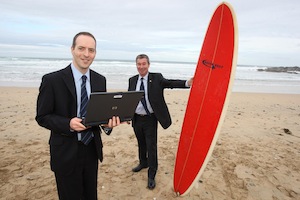
Brits surf different too.
The cost of directly connecting a home to British Telecom’s fiber network will be in the thousands of dollars range. BT has released details on the formula it will use to calculate the charge for running fiber from a neighborhood node – fiber to the cabinet in BT’s terminology – to a home or business.
The minimum charge is £700, about $1,075 at today’s exchange rate. BT says that 55% of its customers can fiber up for somewhere between £700 and £1,500 (about $2,300). Nearly all the rest, BT reckons, would cost anywhere up to £4,000 (about $6,125).
That’s not necessarily what homes or businesses will pay upfront. It’s a wholesale charge that Internet service providers will pay to connect a subscriber to BT’s open access infrastructure. ISPs will then figure out how and how much to charge their end users for the connection. The cost might be passed on via higher monthly rates, for example.
Essentially, BT is implementing a user-financed fiber to the premise business model. Analysis done last year by Tellus Venture Associates for the City of Palo Alto found that too few residential customers would pay a significant upfront connection fee to offset construction and operation costs. Only 26% would pay $1,000 upfront and $60 a month (BT’s price range). At $2,000, the take-rate dropped to 17%. Palo Alto is reasonably well served by AT&T and Comcast, which contributed to the low interest.
BT is also targeting a served market. The same fiber nodes are currently used to provide high speed copper-based service, not unlike AT&T’s Uverse service in California. But BT’s business model is different from Palo Alto’s: it’s the national incumbent provider operating, to a large degree, under government direction. It’ll be interesting to see what sort of take-rate BT gets.
